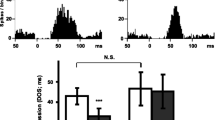Abstract
Mirtazapine (ORG 3770, Remeron®) is a non-selective α2-adrenoceptor antagonist with antidepressant activity in major depression. The aim of the present study was to assess, using an in vivo electrophysiological paradigm, the effect of long-term treatment with mirtazapine on pre- and postsynaptic α2-adrenoceptors and on 5-HT neurotransmission in male Sprague-Dawley rats. A 21-day treatment with mirtazapine (5 mg/kg/day, s.c., using osmotic minipumps) increased the spontaneous firing activity of locus coeruleus noradrenaline (NA) neurons. Their firing activity was back to normal 48 h after removing the minipump. However, this treatment did not modify the dose-response curve of the suppressant effect of the α2-adrenoceptor agonist clonidine on the firing activity of NA neurons. The spontaneous firing activity of dorsal raphe 5-HT neurons was also markedly increased in mirtazapine-treated rats, and was back to normal 48 h after removing of the minipump. The dose-response curve of the suppressant effect of clonidine on the firing activity of 5-HT neurons was altered in mirtazapine-treated rats. Furthermore, it was further shifted to the left after a 48-h washout. Long-term mirtazapine treatment did not modify the suppressant effects of microiontophoretically-applied NA and 5-HT on the firing activity of CA3 dorsal hippocampus pyramidal neurons. However, this mirtazapine treatment antagonized both the enhancing effect of a low dose (10 μg/kg, i.v.) and the reducing effect of a high dose (100 μg/kg, i.v.) of the α2-adrenoceptor agonist clonidine on the effectiveness of the electrical stimulation of the ascending 5-HT pathway in suppressing the firing activity of dorsal hippocampus CA3 pyramidal neurons. After a 48-h washout, only the effect of the high dose of clonidine was attenuated, suggesting a desensitization of the terminal α2-adrenergic heteroreceptor, but not of the terminal α2-adrenergic autoreceptor. The decrease in the effectiveness of the stimulation upon increasing its frequency from 1 to 5 Hz (due to the activation of terminal 5-HT autoreceptors) was unaltered after the long-term mirtazapine treatment. In conclusion, the tonic activation of postsynaptic 5-HT receptors is enhanced by a 21-day treatment with mirtazapine, as a result of a sustained increase in 5-HT neuron firing activity in the presence of decreased function of α2-adrenergic heteroreceptors located on 5-HT terminals in the dorsal hippocampus.
Similar content being viewed by others
Author information
Authors and Affiliations
Additional information
Received: 31 May 1996 / Accepted: 28 August 1996
Rights and permissions
About this article
Cite this article
Haddjeri, N., Blier, P. & de Montigny, C. Effects of long-term treatment with the α2-adrenoceptor antagonist mirtazapine on 5-HT neurotransmission. Naunyn-Schmiedeberg's Arch Pharmacol 355, 20–29 (1996). https://doi.org/10.1007/PL00004913
Issue Date:
DOI: https://doi.org/10.1007/PL00004913




